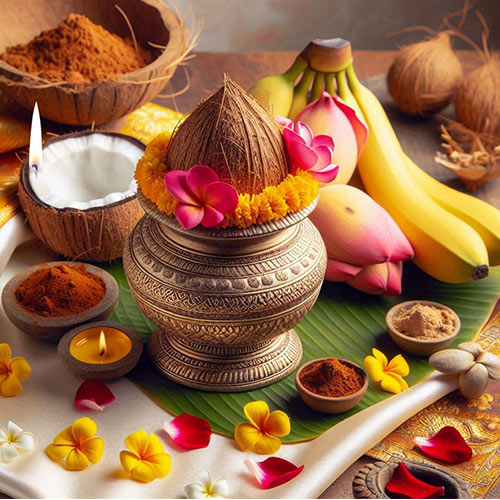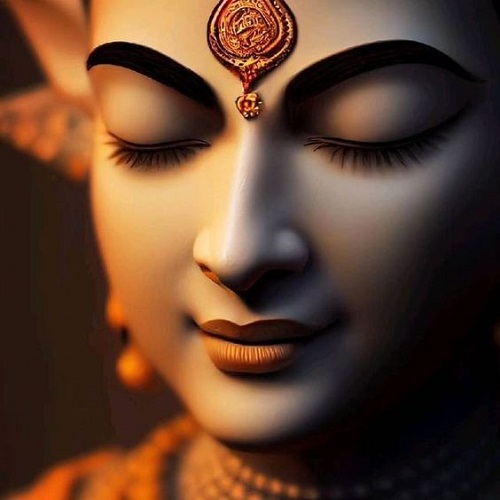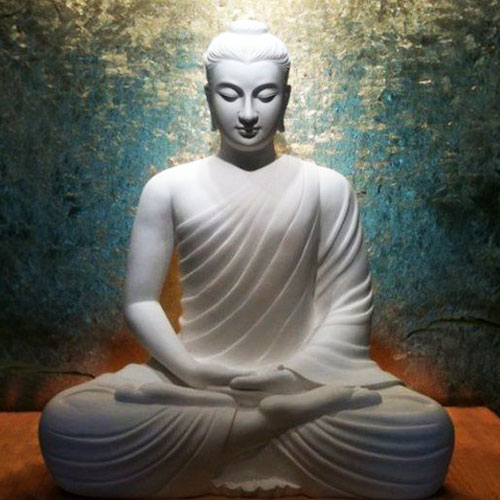The ancient practice of Japa, meaning the repetitive chanting or recitation of a mantra, is a powerful meditative technique rooted in the Vedic tradition. More than just repetition, Japa is a sacred discipline that calms the mind, deepens concentration, fosters inner peace, and supports spiritual growth. To aid this practice, seekers use a Japa Mala, a string of 108 beads, designed not for counting, but for anchoring the mind in mantra meditation. Used across Hinduism, Buddhism, Jainism, and Sikhism, the Japa Mala is both a spiritual guide and a symbol of devotion. When performed slowly and mindfully, especially in its silent form known as Manasikam Japa, the practice becomes a deeply transformative inner journey
What is a Japa Mala?
A Japa Mala is a sacred string of prayer beads traditionally used for the meditative repetition of mantras, known as Japa. The word Mala means 'garland,' and in the spiritual context, it refers to a garland of beads used as a counting tool during mantra chanting. Rooted in ancient Vedic practices, the Japa Mala serves both as a spiritual accessory and a powerful aid for focus and discipline in sadhana (spiritual practice).
A standard Japa Mala consists of 108 beads, plus one additional bead known as the Meru bead or Guru bead. This larger bead is not used for counting but marks the starting and ending point of the mala. The number 108 holds deep spiritual significance across traditions and is believed to connect the practitioner to higher states of consciousness.
Read More: Significance of 108 in Hinduism
The beads can be made from a variety of spiritually significant materials, including Rudraksha Seeds, Tulsi Wood, Sphatik Beads (Clear Quartz), Sandalwood, Lotus Seeds, and Precious/Semi Precious Gemstones. Each material is chosen based on its vibrational quality and the deity or planetary energy it resonates with.
The Japa Mala helps the practitioner maintain concentration during chanting by keeping count with each bead, allowing the mind to stay engaged with the mantra rather than getting distracted. It becomes a sacred tool to deepen meditation, align energies, and enhance spiritual experience.
Buy Rudraksha Japa Mala
Significance of Japa Mala
The Japa Mala is not just a counting tool; it holds deep spiritual, symbolic, and energetic significance in the path of mantra sadhana. It is considered a sacred companion for those engaged in meditation and spiritual practices.
At its core, the Japa Mala helps the practitioner maintain rhythm and focus during the repetition of mantras, preventing the mind from wandering. By moving from one bead to the next with each chant, it fosters mindfulness and discipline, which are essential for effective meditation.
Spiritually, the Mala becomes energized by continuous mantra chanting. Over time, it absorbs the vibrations of the sacred sounds, becoming a storehouse of divine energy. This makes the Mala a personal and powerful spiritual asset, often treated with great reverence.
Furthermore, the act of Japa using a Mala symbolizes the cycle of life, death, and rebirth, going bead by bead in a circular motion reflects the continuous journey of the soul until it reaches liberation (moksha), which is marked by the Guru bead. Pausing at the Guru bead is a gesture of gratitude and surrender to the Divine or one’s spiritual teacher.
Begin Your Journey with Japa Mala
The practice of Japa, supported by the sacred Japa Mala, offers a simple yet profound path to inner peace, clarity, and spiritual awakening. Whether through soft whispers or silent repetition, the steady rhythm of mantra chanting guides the mind inward, helping one connect with the divine essence within. As the beads pass through your fingers, they become milestones on your personal journey toward focus, devotion, and self-realization.
Choose a Japa Mala that resonates with your intention, treat it with reverence, and let it become your daily anchor in the ever-moving flow of life. Your path begins with a single chant, let the Japa Mala guide you every step of the way.
Step by Step Guide to Use a Japa Mala
Using a Japa Mala correctly enhances the spiritual benefits of mantra chanting. Here is a simple step by step guide to help you begin your Japa practice:
-
Sit in a Clean and Quiet Space
Choose a calm place, preferably in your puja room or a dedicated meditation space. Sit in a comfortable position, keeping your spine straight and body relaxed. Try facing East, North or Northeast, make sure to practice your Japa in the same position every day. -
Hold the Mala Properly
Hold the Japa Mala in your right hand. Drape it over the middle finger and use your thumb to move the beads. The index finger should not touch the Mala, as it represents the ego, which must be overcome during spiritual practice. -
Start at the Guru Bead
Begin your chanting from the bead next to the Guru bead (the larger or distinct bead). The Guru bead symbolizes the Divine or your spiritual teacher and should not be crossed over during Japa. -
Chant One Mantra per Bead
With each bead, chant your chosen mantra once, either aloud (Ucchahi), in a whisper (Upamshu), or silently within the mind (Manasikam). Gently move to the next bead with your thumb after each chant. -
Complete One Full Circle
Continue chanting and moving bead by bead until you complete one full circle of 108 beads, ending at the bead just before the Guru bead. Do not cross over the Guru bead. -
If Repeating, Reverse Direction
If you wish to do more rounds, reverse the Mala and begin another round in the opposite direction. Always respect the Guru bead by not stepping over it. -
Focus on Devotion and Intention
Maintain a pure and focused mind during practice. Chant with faith, surrender, and awareness rather than mechanically. -
Store the Mala with Respect
After your Japa session, store the Mala in a clean cloth or pouch, preferably in your puja area. Do not place it casually or let it touch the ground. You can also keep your Mala in a Japa Mala Bag
Explore Japa Mala Bags from Rudra Centre
Benefits of Japa
The practice of Japa, repeating a sacred mantra using a Japa Mala, offers powerful physical, mental, and spiritual benefits. When done with sincerity and regularity, Japa becomes a transformative practice that aligns the individual with higher consciousness.
- Calms the Mind: Chanting a mantra rhythmically soothes the restless mind, reduces anxiety, and helps release negative thought patterns. It creates a state of inner stillness and peace.
- Enhances Focus and Clarity: Japa strengthens concentration and improves mental clarity. As the mind becomes anchored in the sound of the mantra, distractions naturally dissolve.
- Cleanses Aura & Activates Chakras: The vibrations from chanting purify the aura and energize the subtle body. Depending on the mantra and the type of Mala used, Japa can activate specific chakras and balance their energies.
- Attracts Positive Energies: Mantras carry specific divine frequencies. Regular Japa draws in positive cosmic vibrations, creating a protective spiritual shield around the practitioner.
- Deepens Spiritual Connection: Japa strengthens one’s relationship with the Divine or higher Self. It cultivates devotion (bhakti), surrender, and awareness of one’s inner spiritual nature.
- Fulfills Intentions and Desires: When performed with a clear sankalpa (intention), Japa empowers the practitioner to overcome obstacles, gain blessings, and manifest desired outcomes in life.
- Energizes the Mala: Consistent Japa energizes the beads of the Mala, making it a spiritually charged object. Over time, the Mala becomes a source of divine vibrations that benefit the wearer throughout the day.
Rules for Using Japa Mala
Japa Mala beads are sacred tools used in Eastern spiritual traditions to support mantra meditation. They help practitioners maintain concentration and accurately count repetitions. Their use follows specific traditional guidelines covering handling, technique, and spiritual good manners. This guide presents the essential rules and methods for using Japa Mala beads, along with practical adaptations for modern spiritual practice.
Sacred Handling & Care of Japa Mala
Japa Malas are sacred tools, not mere accessories, and should be handled with reverence. When not in use, store the mala in a clean, sacred space, such as an altar, Japa Mala bag, or around the neck of a Buddha statue. It should never touch the floor, as this is considered disrespectful and may diminish its spiritual energy. Remove the Mala before sleeping, during bathroom activities, or intimate relations to preserve its sanctity.
Cleaning and Maintenance
Regular care ensures the longevity and spiritual potency of the mala. For most gemstone, wood, and seed malas, clean them by soaking gently in mild soapy water for up to five minutes, avoiding the tassel. Afterward, brush with a soft toothbrush or wipe with a lint-free cloth, then rinse and dry thoroughly. For delicate stones like Azurite, Turquoise, or Selenite, use a damp cloth instead of soaking. Wooden and seed beads may require oiling (e.g., almond or jojoba oil) to prevent cracking, with excess removed using a soft cloth. Inspect for loose knots or damaged beads to maintain the mala's integrity.
Proper Meditation Technique
To enhance focus and maintain the sacred nature of the practice, hold the mala in the right hand. Use the thumb to move each bead, supporting the bead with the middle finger. The index finger should not touch the beads, symbolizing the transcending of ego. Begin at the first bead next to the guru bead, reciting one mantra per bead. Never cross over the guru bead; instead, reverse the mala’s direction to continue. This honors the guru bead as a spiritual guide.
Traditional Practices and Observances
The best times for Japa are Brahmamuhurta which 1.5 hours before Sunset, Noon when the Sun is right on top of our heads or Sunset. Consistent practice at the same time and place helps deepen the spiritual connection. Physical purity, such as bathing before practice, and sitting in stable, comfortable postures like Padmasana or Sukhasana, enhances meditation. The practice should be done in a clean, quiet environment, ideally facing east or north, directions considered auspicious.
Significance of the Guru Bead
The guru bead represents spiritual guidance and marks the beginning and end of the meditation cycle. It is usually larger or distinct in shape, symbolizing the spiritual teacher, deity, or Higher Self. Practitioners should not touch it with the thumb during recitation but should pause at it for reverence, offering a prayer or intention before either concluding the session or reversing direction.
Contemporary Adaptations and Personal Practice
While traditional rules provide a structured approach, modern practitioners often adapt the mala to suit their personal practices. Many use malas not only for mantra recitation but also for breath awareness or calming the mind. The key remains mindfulness and reverence rather than rigid adherence to every traditional rule.
Empowering the Mala
Empowering the mala involves using it with a specific mantra for 40 consecutive days, after which it is believed to be charged with spiritual energy. This process creates a personal connection between the practitioner and the mala, enhancing its effectiveness as a spiritual tool.
Forms of Japa
There are three main ways to practice Japa, each offering different levels of depth and effectiveness.
Ucchahi Japa (Loud Recitation)
This form involves chanting the mantra out loud, so it can be clearly heard by others. It is often used in group chanting or for beginners who need help focusing. Loud chanting helps create a strong vibration in the environment, but it can also distract the mind if not done with awareness.
Upamshu Japa (Soft Whispering)
In this method, the mantra is whispered very softly, just loud enough for the practitioner to hear. It is more personal and inward than loud chanting. Upamshu Japa helps draw the mind inward while still giving the tongue and breath a gentle rhythm to follow. This makes it more effective than loud chanting for quiet meditation.
Manasikam Japa (Mental Repetition)
This is the most subtle and powerful form of Japa. The mantra is repeated silently in the mind without moving the lips or tongue. Because it is purely mental, it requires greater focus and control, but it also leads to the deepest state of meditation. Manasikam Japa is considered the highest form because it brings the mind into direct contact with the divine energy of the mantra
Popular Types of Japa Mala
Japa malas, or sacred prayer beads, have been used for centuries in Hindu spiritual practice to aid in meditation, mantra chanting, and inner alignment. Each type of mala is made from distinct sacred materials like Rudraksha, Tulsi, Sandalwood, or even Crystal, each carrying unique spiritual, therapeutic, and symbolic properties.
Rudraksha Mala
Rudraksha malas are sacred prayer garlands made from the Rudraksha seed, revered in Hinduism for their divine vibrations and transformative energies. Each bead features natural lines called 'mukhis' or faces, with each type offering distinct metaphysical benefits. For instance, the 5 Mukhi Rudraksha, the most commonly used, enhances clarity, intellect, and inner balance, making it ideal for mantra recitation and meditation. The 7 Mukhi variety resonates with the blessings of Goddess Lakshmi and is known to attract wealth and success. These malas come in two main varieties: Nepali, with larger, deeply grooved beads that emit powerful vibrations, and Java, with smaller, smoother beads preferred for discreet daily wear. Regardless of origin, Rudraksha malas are treasured for harmonizing the body, mind, and spirit, and for offering spiritual protection, focus, and vitality.
Tulsi Mala
Tulsi malas are crafted from the sacred wood of the Tulsi plant, venerated as a divine manifestation of Goddess Lakshmi and beloved by devotees of Lord Vishnu, Krishna, and Rama. These beads are believed to purify the aura, remove karmic burdens, and protect the wearer from evil influences. Tulsi beads are shaped into round, cylindrical, and lingam-like forms, each suitable for specific spiritual uses. Larger beads are commonly used for japa or mantra counting, while smaller ones are worn for constant spiritual connection. In addition to their spiritual merit, Tulsi beads are esteemed for their healing properties, known to reduce stress and align the energies of the heart and mind.
Buy Tulsi Mala
Sandalwood Mala
Sandalwood malas are made from the aromatic wood of the revered sandalwood tree, long prized in Indian culture for its cooling and sattvic (pure) nature. These malas are widely used for Japa (mantra repetition), promoting mental clarity, emotional calm, and enhanced focus. White sandalwood is particularly auspicious for rituals aimed at peace, meditation, and divine attunement. Red sandalwood, also called rosewood, is associated with power and is used in the worship of deities like Lord Ganesh and various forms of the Divine Mother. The soothing fragrance and grounding quality of sandalwood make these malas ideal for spiritual seekers and healers alike.
Buy Sandalwood Mala
Red Sandalwood Mala
Red sandalwood, or rosewood, is used to make malas that are especially favored in Tantric practices and the worship of deities like Lord Ganesh, Kali, and Durga. These malas are believed to enhance strength, determination, and rootedness in spiritual practice. Known for their subtle reddish hue and earthy fragrance, red sandalwood beads are often used to energize rituals, stabilize emotions, and aid those seeking to overcome inertia or fear. Their use is recommended for sadhakas aiming to awaken inner power and perseverance.
Buy Red Sandalwood Mala
Karungali (Ebony) Mala
Karungali malas, made from the sacred ebony wood, are esteemed for their deep grounding and shielding properties. Although not always widely discussed in mainstream sources, ebony wood has been traditionally regarded as a powerful spiritual protector, capable of absorbing and neutralizing negative energies. These malas are often chosen for deep meditation, serious spiritual disciplines, and by those seeking energetic stability and protection in turbulent environments. Karungali beads are typically dark, dense, and smooth, symbolizing strength and inner resilience.
Sphatik (Crystal) Mala
Sphatik malas, made from clear quartz crystal, are celebrated for their purity, clarity, and ability to amplify spiritual energy. They are ideal for mantra japa, as they retain the vibrations of chants and enhance mental focus. Wearing a sphatik mala is said to harmonize the chakras, dissolve negativity, and bestow mental peace. Particularly favored for Goddess Lakshmi worship and meditative practices dedicated to Lord Shiva, these malas are also believed to promote restful sleep, emotional balance, and overall well-being by resonating with high-frequency vibrations.
Buy Sphatik Mala
Vaijanti Mala
Vaijanti malas are made from the gleaming seeds of the Vaijanti plant, traditionally associated with victory, devotion, and spiritual conquest. Devotees of Lord Vishnu and Krishna often use these malas for chanting mantras and invoking divine grace. Symbolizing triumph over obstacles and inner purity, Vaijanti beads are also worn for their protective and confidence-boosting properties. Their smooth, light texture and silver sheen make them both elegant and spiritually empowering, ideal for those on the path of bhakti (devotional) yoga.
Buy Vaijanti Mala
Haldi (Turmeric) Mala
Haldi malas are crafted from the roots of turmeric, a spice deeply revered in Vedic rituals for its cleansing and auspicious nature. These bright yellow beads are traditionally used in Anusthan (intensive spiritual practices) to overcome adversity, particularly in matters of legal issues, health, or energy blockages. Turmeric’s anti-inflammatory and purifying properties extend beyond the physical to subtle energetic realms, helping to remove fear, clear stagnation, and uplift the spirit. The mala serves as a sacred tool for transformation and healing.
Buy Haldi Mala
Lotus Seed Mala
Lotus seed malas, or Kamal Gatta malas, are deeply symbolic, representing purity, rebirth, and spiritual awakening. Derived from the seed of the lotus flower, which thrives even in muddy waters, these malas inspire resilience and inner growth. They are especially used in practices dedicated to Goddess Lakshmi, invoking abundance, grace, and beauty in one’s life. The natural texture and sacred association of lotus seeds make them ideal for practitioners seeking both material success and spiritual elevation.
Buy Lotus Seed Mala
Each of these Japa malas carries its own sacred essence and unique vibration, enabling practitioners to select the one that best aligns with their spiritual aspirations, deity devotion, or healing intentions.
Which Mantras to Chant while using Japa Mala?
One can chant any Mantra on any Japa Mala, however there are a few mala which are suited to do particular Mantra & Deity Sadhanas
|
Mala Type
|
Mantra
|
Associated Deity
|
Benefits
|
|
Rudraksha
|
Om Namah Shivaye
|
Lord Shiva
|
Peace, purification, detachment, transformation
|
|
Tulsi
|
Hare Krishna Hare Krishna Krishna Krishna Hare Hare Hare Rama Hare Rama Rama Rama Hare Hare
|
Krishna/Vishnu
|
Divine protection, surrender, liberation
|
|
Sandalwood
|
Om Mani Padme Hum / Om Namah Shivaya
|
Shiva / Buddha
|
Mental clarity, focus, spiritual grounding
|
|
Red Sandalwood
|
Om Namo Narayanaya
|
Lord Vishnu
|
Enhances devotion, calms anger, strengthens discipline
|
|
Vaijanti
|
Om Namo Bhagavate Vasudevaya
|
Lord Vishnu / Krishna
|
Victory, success, overcoming enemies, charm and attraction
|
|
Sphatik (Quartz)
|
Om Namah Shivaya / Om Aim Hreem Kleem Chamundaye Vichche
|
Devi / Shiva
|
Amplifies energy, clarity, healing, peace
|
|
Lotus Seed
|
Om Shreem Hreem Shree Mahalaxmiyei Namah
|
Goddess Lakshmi
|
Wealth, prosperity, abundance, spiritual growth
|
You can use Rudraksha Mukhi Malas to do Sadhana of a specific Mukhi’s Ruling Deity.
For Example 8 Mukhi is ruled by Lord Ganesh therefore one can use 8 Mukhi Mala to chant “Om Gang Ganpataye Namah” and do Ganpati Sadhana.
Why buy Japa Malas from Rudra Centre?
Purchasing Japa Malas from Rudra Centre offers a range of compelling advantages, making it a trusted choice for spiritual seekers. As an ISO 9001:2015 certified organization, Rudra Centre ensures the highest quality standards, offering handpicked Rudraksha beads with superior quality and deep mukhi lines. We provide personalized spiritual guidance through Rudraksha Ratna Chakra Therapy, helping customers select the most suitable Japa Mala based on their individual chakra analysis. With an extensive range of spiritual products, including gemstones, yantras, and pooja services, Rudra Centre meets all spiritual needs in one place. Our reliable and fast global delivery service is complemented by thousands of positive customer reviews, highlighting our expertise and commitment to customer satisfaction. Trusted by clients worldwide, many have experienced positive transformations in their spiritual practices and daily lives after using our extensive range of Japa Malas crafted in manifold materials.
Explore Rudraksha Malas
Explore Spiritual Malas
Explore Gemstone Malas


-in-Astrology.jpg)






.jpg)



Comments 0
Leave your thought here